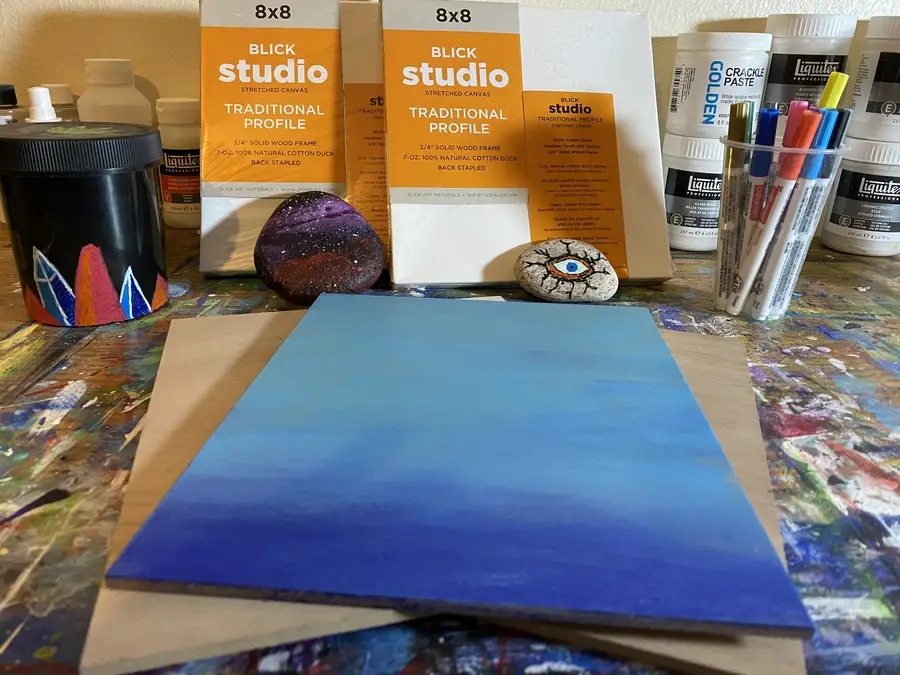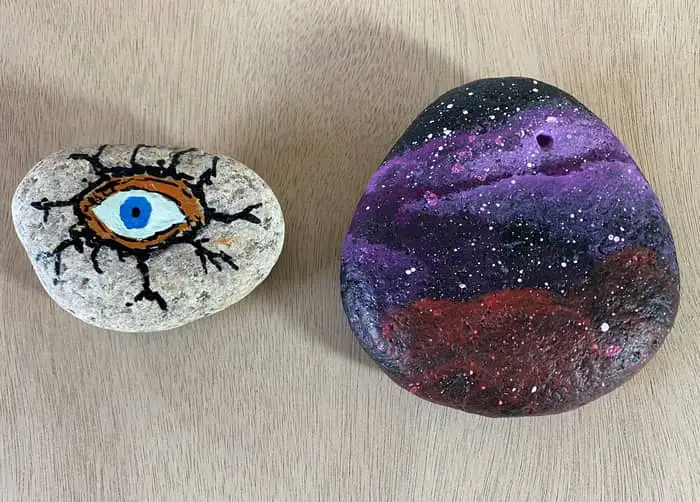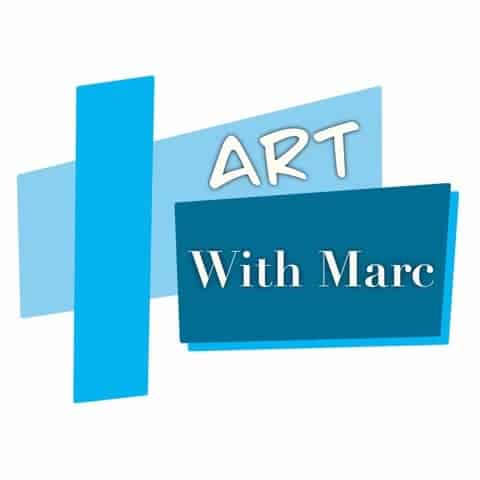
Acrylic paint can be used on many different types of surfaces. Some of these surfaces may require prepping in order for the paint to adhere properly while others are ready to go.
Still others will require being baked in the oven to properly cure and make dishwasher safe.
Some types of surfaces, like fabrics and ceramics, require specific types of mediums and specialty acrylic paints to get high-quality results.
By the time you’re done reading this page, you will know all the various types of surfaces you can use acrylic paint on!
Stretched Canvas, Canvas Rolls, and Canvas Panels

This one pretty much goes without saying. It is by far the most common and traditional surface to paint on. Canvas is typically what most people think of when they think of paintings.
There are four basic types of canvas to choose from.
- Stretched Canvas
- Canvas Rolls and Stretch Bars
- Canvas Boards and Panels
- Canvas Pads
Stretched canvas is the most common and likely what most people think of when they think of canvas. When it comes to stretched canvas you can get them in a variety of sizes as well as thicnkesses.
Once you start getting confident in your painting skills and want to stock up on stretched canvas, you can get a discount if you buy 10 or more over at dickblick.com.
Canvas rolls and stretch bars are for artists looking to save some money by building their own canvases. I have yet to explore this option but Ed over at the Swarez Art youtube channel has a great demonstration of how to do this.
Canvas boards, panels, and pads are all cheaper options you can go with as well.
For beginner artists looking to develop their skills on canvas while saving some money, we can find some great deals on panels. I personally shy away from recommending this option as in order to hang it you need to frame it.
I want you to be able to hand your painting when you complete it. That said, everyone has their preferences and I would encourage you to find yours.
If there is something more appealing about canvas panels that draw you in then I would encourage you to go that route.
For more in-depth details on each of these options check out “The Beginners Quick Reference Guide” I wrote on canvases here.
Mixed Media Pads and Acrylic Painting Paper
When it comes to acrylic painting on paper, if you want it to last or have archival quality, there are a few things you should know. Not just any paper will do for quality results.
If you want to keep whatever you are painting when you are done you will want to go with weighted paper.
Weighted paper is a thicker paper that absorbs the paint better without warping. The heavier the weight the thicker the paper is.
For quality results, you will want to go with paper that is at least 90 lbs or higher. There are some types of watercolor paper that will meet this requirement and are suitable for acrylics.
Acrylic paints are also water-soluble so you could potentially water your acrylics down a bit to get that watercolor effect as well.
That said there are plenty of options to choose from that are designed with acrylic paints in mind.
There are great mixed media notebooks you could go with as well. I just ordered the Bienfang Mixed Media Pad. It comes with 40 sheets of paper weighted at 90lbs.
While 90 lbs is acceptable the vast majority of the options out there specifically made for acrylic painting are higher than 120 lbs.
For a more detailed review of the various brands of paper suitable for acrylic painting check out this page I wrote on “Paper For Acrylic Painting” here!
Related Articles:
- How To Use Acrylic Paint On Wood: Prepping to Paint
- Paper For Acrylic Painting (A CHEAP Alternative to Canvas!)
- Canvas for Acrylic Painting: The Beginners Quick Reference Guide
- The Things You Can Wash Acrylic Paint Off Of (A Quick Guide)
- Acrylic Paint Pens and Markers: What Can You Use Them For?
Hardwood, Plywood, and Wood Paneling

Many great artists throughout history and some of the greatest works of art in the world have been painted on wood.
One of the good things about wood for archival quality, or the amount of time your art will last, is that wood will never need to be re-stretched like canvas may need to be.
It is possible for the wood to become warped if not properly taken care of. This outcome should be avoidable if properly sealed and stored.
Canvas over time can become loose and stretched out causing it to need to be re-framed every now and then for it to remain tight on the framing.
For the best results, you’ll want to make sure to select the right type of wood. You can choose from hardwood, plywood, wood paneling, wood slices, and even wood furniture!
Just be sure to sand and prime your surface before beginning!
For more details on the various types of wood products available for you to choose from click here to check out my page on “Wood For Acrylic Painting”.
Next we will head into less traditional territory.
Acrylic Paint on Metal by Sanding and Priming

Acrylic painting on metal surfaces can be done once you prep the surface properly. There are a number of benefits to painting on metals surfaces too.
When it comes to the types of metal surfaces you might be interested in painting on, this section doesn’t really have product options that are made specifically for artists interested in this.
So if this is something you’re interested in trying we will have to get creative in sourcing our products. There are a variety of metallic household items one may be interested in painting.
Things like various wall decor or garden ornaments. Perhaps you have a metal sculpture like the ones pictured above you want to paint. We could even purchase thin metal sheets from our local hardware store if we wanted.
This way we could create a work of art that can still be framed and hanged yet get the metallic effects we might want.
To use acrylic paint on a metal surface you need to start by sanding your surface lightly with a fine-grit sandpaper. This is assuming you are starting with a clean surface that hasn’t previously been painted or has any rust.
If your object has any of that you will want to look up how to properly remove those things first.
Once you sand your surface then wipe any of the dust away with a rag. After that, you will want to wash the surface with soap and water. Then sand it again.
Now you are ready to prime your metal surface. You want to make sure you are using a primer meant for metal and that is compatible with acrylic paints.
I will do more research on this soon when I’m ready to dedicate a whole page to this topic but for now, Rust-Oleum Primer seems to be the only recommendation I can find.
I’m sure there are many other options to go with and ones that will allow the metal sheen to shine through the paint. Which is one reason we might want to paint on metal to begin with.
Acrylic Paint on Rocks with Gesso or Paint Pens

Believe it or not you CAN actually use acrylic paint on rocks. Not only that, as with nearly everything we cover on this site, there are several options to do it too!
Well, two basic options really. The first is to use acrylic paint pens.
There are many paint pens and markers to choose from. Some come with sealers mixed into them so that when they dry they are resistant to the elements.
The second option is to prep your rock with several layers of gesso before you start painting with your regular acrylic paints.
The cool thing about rock painting is all you have to do is keep an eye out for a good rock while you are out and about. The only cost to you would be to get the paint pens or gesso if you don’t already have either of those in your art collection.
You can also have fun leaving them as little gifts for others to find!
Acrylic Paint on Fabric with Fabric Mediums
Acrylic paint can be used on fabrics both with and without a fabric medium. It all depends on what sort of fabric you are putting your artwork on and what it’s intended use is.
I certainly have stained my fair share of clothes with just regular acrylic paint. So if you have any fabric you might want to paint and just put up on display, you should be able to get good results without the use of any sort of fabric medium.
For any painting project that you might have that will get wear and tear to them, like maybe some shoes or a jacket, you will want to get a fabric medium.
That said, I have seen artists paint on shoes without fabric mediums. Lanchen Designs demonstrates in the video above how she paints galaxies on shoes using just acrylic paints.
I question the longevity of the results when doing it like this. Especially for something that is going to be worn on your feet.
For fabrics that you want to be able to wash and that will undergo wear and tear you need something that won’t come off over time. The fabric medium will give your acrylic paints more elasticity.
Allowing them to dry on fabric and be washed without any cracking. Not just that, allowing them to move around.
Even though canvas is a fabric itself it is stretched tightly across a frame preventing it from moving in the same way that our clothes might.
With the fabric medium, our acrylic paint will now be able to flex with the curves of the fabric without breaking off. Enabling your project to have durability so that it will last.
Paint On Glass with Acrylic Paint or Glass Paint
When you are looking to do a piece of artwork on glass, how you want to approach it depends on what sort of results you are looking to get. Do you want a display piece or are you looking for something with more functionality?
As an example, let’s say you have a glass jar or bottle you would like to paint. Acrylic paint would be fine for pieces like these.
You can easily paint on them with whatever type of acrylic paints you may have once you cover them with a few layers of gesso. If your glass painting project is going to be a simple display piece gesso is all it takes.
You can also just try painting straight on the glass too.
You do want to be sure to clean them up first with soap and water. Then use rubbing alcohol to dampen a paper towel and rub down the surface of the class where you will be painting.
Once you complete your painting let the painting dry completely. Then once it is dry you can cure it in the oven. Always place glass items in a cool oven and heat the oven up with them inside the oven.
Bake at 300 degrees for 30 minutes and then let the oven cool down with the glass inside.
If you’re going to be using this method to paint any glassware you may be using to drink out of you will want to keep in mind not to paint too close to where people might be putting their lips.
Not all paints are suitable to being exposed to food and drink. Especially if you’re using just plain acrylic paint. There are glass paints that are non-toxic and suitable for these purposes though.
There is also a glass and tile medium made by a brand called Folkart that you can pick up at your local Joann’s that you can use to mix with your acrylic paints.
Folkart also makes a line of acrylic multi surface paints that would be great for using on glass cups or even wine glasses!
Beyond your basic acrylic paints, there are a variety of glass paints and glass paint markers to choose from too. There is more to explore when it comes to painting on glass than I expected.
I will certainly be looking to do a deeper dive on these products and glass painting myself soon.
Acrylic Paint on Ceramic Mugs and Porcelain
Many of the special paints suitable for glass painting are also useful when painting ceramics and porcelain.
In fact, we can use the same process as we used on the glass. Instead of going over the exact same process that we did on the glass in the above example using acrylic paint, let’s cover the other types of paint you may be interested in trying.
Folkart, the brand we mentioned that makes the glass and tile medium for acrylic paint, also makes multi-surface acrylic paints. These particular paints are safe for use on items that will be used for food products or drinks.
It’s non toxic and can be cured in the oven at roughly 300 to 350 degrees.
Your next option is a brand called Pebeo Porcelain 150 Paint, which you can grab over at DickBlick.com here.
This particular brand is also non-toxic and dishwasher safe. Despite it being non-toxic it is not recommended for use on surfaces that will come into contact with food.
So when using it to paint something like a mug you just want to be sure not to paint in areas where a persons lips might come into contact with it.
Then there is also the Pebeo Ceramic Paint too. I’m not entirely sure what the difference are between these two brands as they both seem to be usable on porcelain or ceramics.
Then there is the Pebeo Porcelain 150 Paint Markers for those who prefer the uses of markers over brushes. They are a great way to add that fine line work or cute saying to your mug! Click here to check them out!
With so many choices I’m getting myself excited here to give this a try! Just think, maybe if you get good at it you can get a little side income coming in through an Etsy store.
Hand made mugs go for at least $20 bucks a piece on Etsy!

